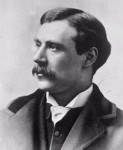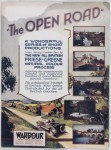A reader — he knows who he is — pointed me to this video, a remarkable color film of London in 1927 that has been making the Internet rounds the past couple of days. The uploader notes that it’s the work of British film pioneer Claude Friese-Greene using a color process invented by his father William. The name rang a bell because last year I wrote an entry about the restoration of the earliest natural color movies (as opposed to ones shot in black and white and then tinted by hand afterwards), experimental films shot in 1902 by Edward Raymond Turner using a three-color process patented in 1898 which he was never able to develop into a practical working model of camera and projector.
After Turner’s premature death, investor and American film producer Charles Urban hired early film pioneer George Albert Smith to continue where Turner had left off. Smith simplified the Turner process by dropping the blue and turning it into a two-color red and green process called Kinemacolor which Urban and Smith patented in 1906. The black and white film was shot through red and green filters and then projected through them. Even though it required special projectors, Kinemacolor was a hit from its first public showing in 1908. At its peak popularity, more than 300 theaters in Britain had installed Kinemacolor projectors.
 It was William Friese-Greene who dethroned Kinemacolor. An avid photographer and inventor — he got more than 70 patents for his inventions during his lifetime — William Friese-Greene drove himself into bankruptcy repeatedly with his passion for moving pictures. One of his inventions was a two-color red and green film process he called Biocolour which he patented in 1905. The process required exposing alternate frames of film through red or green filters and then staining them red (for the green filtered frames) or green (for the red filtered frames). The end result suffered from flickering and very visible red and green edges around figures in rapid motion, but so did Kinemacolor. That was the nature of the beast with these early two-color systems.
It was William Friese-Greene who dethroned Kinemacolor. An avid photographer and inventor — he got more than 70 patents for his inventions during his lifetime — William Friese-Greene drove himself into bankruptcy repeatedly with his passion for moving pictures. One of his inventions was a two-color red and green film process he called Biocolour which he patented in 1905. The process required exposing alternate frames of film through red or green filters and then staining them red (for the green filtered frames) or green (for the red filtered frames). The end result suffered from flickering and very visible red and green edges around figures in rapid motion, but so did Kinemacolor. That was the nature of the beast with these early two-color systems.
In 1911, he tried to sell his system to filmmakers and movie theaters. Biocolour had one great advantage over Kinemacolor: it played through regular projectors, no special equipment necessary, but Kinemacolor’s popularity and the strength of its patent stopped him in his tracks. Urban filed an injuction against Biocolour Limited in 1912, on the grounds that Biocolour’s two-color red and green process was an infringement of Kinemacolor’s 1906 patent. Friese-Greene challenged the injunction on the grounds that Kinemacolor’s patent was too broadly written and not detailed enough to cover the Biocolour process. He lost in the lower courts but an appeal to the House of Lords was ultimately decided in Friese-Greene’s favor in 1915 because Smith had not specified in the patent which exact colors were necessary for his process to work. He claimed that any two colors from nature would work, which was not at all the case, hence the years of struggle from Turner’s first experiments until Smith’s success with red and green.
 William Friese-Greene’s win killed Kinemacolor, but with no funding and a World War going on, he was unable to convert his legal victory into theatrical success. He died penniless in 1921. His son Claude picked up where his father left off, developing and improving Biocolour. In the mid-1920s, Claude traveled the length of Britain from Land’s End in Cornwall to John o’ Groats in Scotland, filming in the “new all British Friese-Greene natural colour process.” The result was a travelogue of Britain in 26 ten-minute episodes called The Open Road which is the source of those shots of London linked to above.
William Friese-Greene’s win killed Kinemacolor, but with no funding and a World War going on, he was unable to convert his legal victory into theatrical success. He died penniless in 1921. His son Claude picked up where his father left off, developing and improving Biocolour. In the mid-1920s, Claude traveled the length of Britain from Land’s End in Cornwall to John o’ Groats in Scotland, filming in the “new all British Friese-Greene natural colour process.” The result was a travelogue of Britain in 26 ten-minute episodes called The Open Road which is the source of those shots of London linked to above.
Here’s the full London shoot done in 1927 at the end of the three-year voyage. The little girl selling peanuts at the cricket match slays me.
[youtube=http://youtu.be/TwahIQz0o-M&w=430]
You’re not seeing what audiences would have seen, however. The British Film Institute digitally restored the film to remove the flickering and clean up the color. The entire film was shown on British television in a BBC documentary series in 2006. The DVD is available on the BFI website.
The British Film Institute’s YouTube Channel has more than 60 extracts from The Open Road, most of them less than a minute long but all of them riveting. The color film has a way of making these scenes, now almost a century old, feel much closer to our present. At the same time, they are still very much of a time gone by, an immensely compelling combination.
My favorite scenes are the ones that capture people at work. There are fishermen bringing in the catch and herring girls gutting it in Oban, Scotland (1926):
[youtube=http://youtu.be/KECs39ticQk&w=430]
Three generations of weavers in Kilbarchan, Scotland (1926):
[youtube=http://youtu.be/4TDftulY8Ag&w=430]
Harvesting on Earl Bathurst’s Estate using traditional oxen in Cirencester (1924):
[youtube=http://youtu.be/_4k5hcndldI&w=430]
A potter at his wheel and the ladies painting Wedgwood Etruria pottery (1926):
[youtube=http://youtu.be/xY6iHx_07tk&w=430]
I also love the ones where Claude took full advantage of the red and green process by filming things that are particularly red and green.
Dingle Gardens Shrewsbury, Shropshire (1926):
[youtube=http://youtu.be/dInFWovSWps&w=430]
Gingers enjoying a bathe by the sea at Torquay, Devon, in 1924:
[youtube=http://youtu.be/lEK2qeuoNVg&w=430]
From a historical perspective, I love the Roman baths in Bath in 1924 and the charming utter lack of thrills and chills on the Reed, a ride at Blackpool Pleasure Beach, Lancashire, in 1926.
[youtube=http://youtu.be/30Bj06lYYJ0&w=430]
[youtube=http://youtu.be/VvUjbKUBMmo&w=430]
Really I could post every last one of them. There are no duds here. I highly recommend spending a few hours watching them all, which is exactly what I did today.
Thank you. These color films took my breath away. I could not tear my goggle-eyed gaze from any of them! Stunning!
Aren’t they amazing? They need to release the entire film in Region One encoding or at least carry it on US television because I want to see the whole thing in order the way Friese-Greene intended.
I love this kind of stuff, but it’s always a bit frustrating when the cameraman decides that buildings are what people want to see.
No. Give me cars and buses and peanut girls and curious faces close enough to see the expressions.
(Then again, I suppose I would feel differently if Tower Bridge and the Parliament building hadn’t made it through the war, so there’s that.)
I love the people the most too, but yeah, you’re right: we’d have a whole other reaction if the Houses of Parliament were no more.
I am dumbfounded by your awesomeness, mr drusus. My first and p much only thought at the first link was “hey! it’s london! from a long time ago!” I felt some phantom nostalgia-cum-voyeurism at the fashions and autos and marveled a bit at how the city once looked. A lot is different and a lot is the same.
If only that magic ticket from the Last Action Hero were a thing, right? Imagine traveling through time via the cinema into the almost real worlds, real and imagined. Too bad, but what we’re left with can still be wondrous.
:hattip:
Oh man, I would kill for that magic ticket from Last Action Hero. Short of that, we’ll have to make do with startlingly present color film from 90 years ago.
These are wonderful! I keep stopping to pore through Google Maps to find modern views of these places. Some places have hardly changed at all, like Parliament from across the Thames. It really brings home to me what a baby nation we are here in the US, where you’d be hard pressed to find a single spot in a city where the view is so unchanged.
People and places in old pictures tend to feel foreign to me, perhaps because fashions and technology and just stuff are all so superficially different. But seeing people actually moving around on the streets and smiling shyly at the camera (or gawping and trying to stay in the shot!) makes it all seem very, very real. I love them!
I love that view of Petticoat Lane where everyone and his uncle keeps turning towards the camera. If there had been sound, you know they would have been sending shoutouts to their moms. It really does give you a sense of communality with the past, even as the landscape, fashions and professions change.
Oh man, these are fantastic! Thanks so much!
My pleasure. I’m glad you enjoyed them. 🙂
Thank you for posting! The films are beautiful and one gets a sense of what London and Scotland were like before WWII.